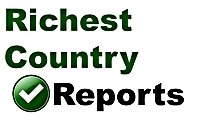Formally named the Islamic Republic of Iran and historically referred to as Persia, Iran is flashing red on a set of key business cycle indicators. Clearly, the Middle Eastern economy is mired in recession.
Case in point: Iran’s Gross Domestic Product (GDP) performance on a Purchasing Power Parity (PPP) basis slipped by -7.8% at October 2019 compared to one year earlier.
GDP tracks a long-term growth trend via business cycles of growth or recession that repeat approximately every 5 years or so, albeit that no two business cycles mirror the same duration or size. America’s National Bureau of Economic Research found that there were 33 business cycles from 1854 to 2009.
The average length of an expansion is 38.7 months compared to 17.5 months during a recession. Historically, the longest economic contraction in the United States was the 1929 Great Depression that lasted 43 months. That’s more than double the 18-month duration for the Great Recession which began in 2007 and was caused by the real estate bubble created during the 1991 to 2001 boom states Cameron King in his analysis for Forbes.
Cyclical indicators are erratic with multiple major influences. Worse, there is no consensus for which indicators universally signal business cycles in all cases.
Nevertheless, The Economist organizes its benchmarks into 3 critical categories: leading indicators that turn in advance of a cycle change; coincident indicators that define when the overall business cycle turns; and lagging indicators that top out following a business cycle.
Iran’s Leading Business Cycle Indicators
The 3 selected leading indicators for Iran show very sluggish growth for general consumer spending compared to 12 months earlier. The spending slowdown is complicated by extremely high prime interest rates and a severe reduction in passenger car sales.
The Economist estimates that an economy hits its highest level about 18 months after interest rates begin to rise compared to 8 to 16 months for waning business and consumer confidence. There are shorter timeframes in advance of an economy’s GDP peak for slowdowns in car sales (6 months) and consumer spending (2 to 3 months).
- Interest rates: 18% at Oct. 2019 (same as 12 months earlier)
- Consumer spending: US$16.83 billion at Dec. 2019 (up 0.4% from $16.77 billion)
- New car sales: 650,000 vehicles at Nov. 2019 (down -28.8% from 912,563)
High interest rates can result in heavy debt which can expand relatively quickly, thus handicapping both consumer and business confidence.
The car sales metric specifies the number of new passenger cars sold irrespective of price.
Iran’s Coincident Business Cycle Indicators
Percent changes in Gross Domestic Product (GDP) on a Purchasing Power Parity (PPP) basis are much-scrutinized headline numbers that define whether an economy is contracting or expanding. That’s because year-over-year GDP changes coincide with and thus signal the start of a recession or boom period.
The latest GDP on a PPP basis statistics reveal that the Islamic Republic of Iran’s economy is deteriorating given the negative annual growth that is approaching double-digits.
- GDP: US$1.471 trillion at Oct. 2019 (down -7.8% from $1.596 trillion)
- GDP per capita: $17,662 at Oct. 2019 (down -8.9% from $19,377)
Please note that Iran’s share of the world’s overall GDP of $141.860 trillion was 1% at October 2019, down from 1.2% one year earlier.
In addition, Iran’s GDP per capital of $17,662 is about 4% less than the global average GDP per person of $18,391 as of October 2019.
Iran’s Lagging Business Cycle Indicators
While Iran’s overall capital investments improved by 2.1%, the other 2 selected lagging indicators deteriorated compared to the same metrics in the prior year.
Usually capital investment shadows GDP peaks and valleys via a 12-month delay. Both inflation and unemployment accelerate about 6 months after GDP reaches its maximum growth.
- Capital investment to GDP ratio: 40.8% in 2019 (up 2.1% from 38.7% in 2018)
- Unemployment rate: 16.8% in 2019 (up 2.3% from 14.5%)
- Inflation rate: 35.7% in 2019 (up 5.2% from 30.5%)
The ratio of capital investment to GDP is a lagging but future planning-oriented indicator that records the value that a country spends on capital development and infrastructure projects divided by its overall GDP output on a PPP basis.
Unemployment rate is a crucial percentage based on a country’s total labor force (not its full population) since it profoundly impacts how many debtors can afford to pay their mortgages and other borrowings.
Inflation rate documents the percentage change in average consumer prices in a country over a one-year period.
See also Domestic Spending for Top 25 Richest Countries, Trade Surpluses or Deficits for Top 25 Richest Countries and Household Debt for Top 25 Richest Countries
Research Reference Materials:
CEIC, Iran Motor Vehicle Sales: Passenger Cars. Accessed on January 3, 2020
International Monetary Fund, Interest Rates selected indicators, World Economic Outlook Databases. Accessed on January 3, 2020
Focus2Move, Iranian Vehicles Market. Accessed on January 3, 2020
National Bureau of Economic Research, US Business Cycle Expansions and Contractions. Accessed on January 3, 2020
The Economist, Guide to Economic Indicators: Making Sense of Economics (7th Edition). Accessed on January 3, 2020
Trading Economics, Iran Consumer Spending, Interest Rate listing. Accessed on January 3, 2020
Wikipedia, Consumer confidence index. Accessed on January 3, 2020

